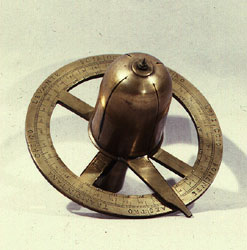 82. Surveyor’s cross
82. Surveyor’s cross
A direct descendent of the old Roman instrument the groma, the cross was a useful device for measuring the planimetry of points, lines and areas by means of rectangular coordinates. It was considered a simple and accurate instrument, better suited than others for map surveying and identifying important points.
It was an indispensable adjunct to the "land-surveyor’s chain". It was placed on top of a rod with the sighting slots at 90 degrees to each other; an orthogonal measuring system was used to determine the position of land features and buildings which lay to the side of the straight line drawn by the chain.
This slotted cross is movable on a circle 14 cm in diameter, divided into degrees and carrying indication of the winds. Its orientation vis-à-vis the circle can be read from an alidade fastened to the cross. At the top of the cross is a point beneath which there is a conical holder for the staff-support.
F. Farinelli (1979), pp. 189, 190.